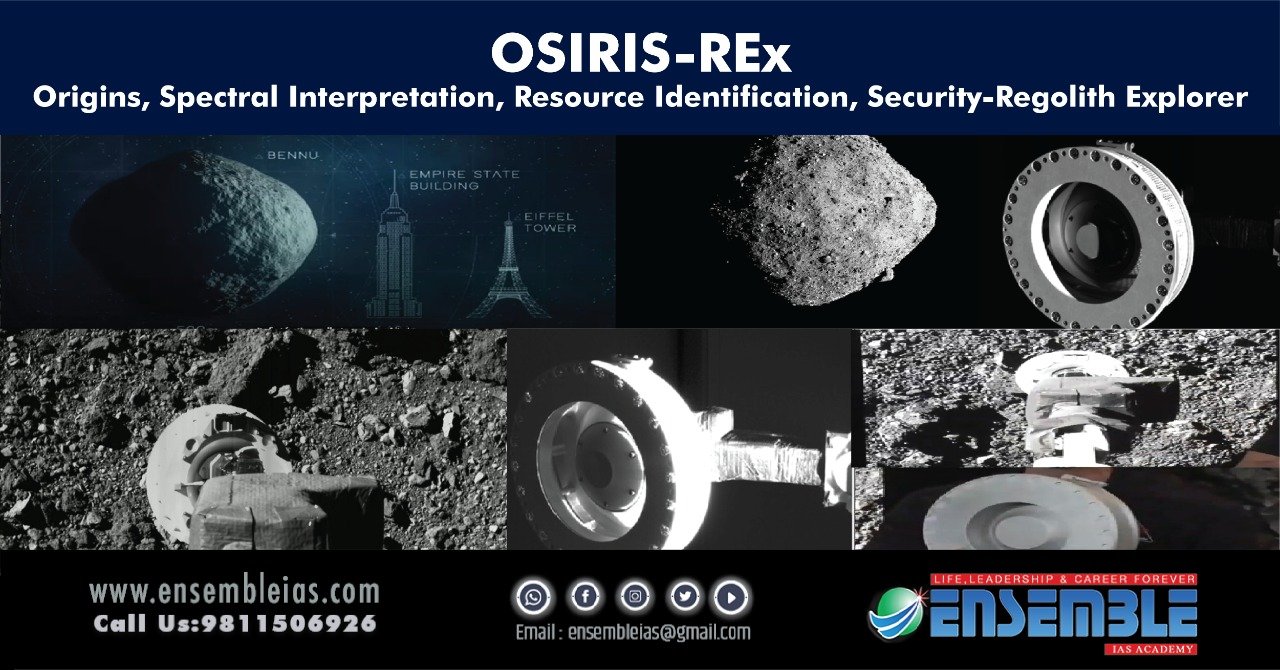OSIRIS-REx Origins:
OSIRIS-REx Origins, Spectral Interpretation, Resource Identification, Security- Regolith Explorer
To buy our online courses: Click Here
The mission
● NASA’s most ambitious sample collection program left Cape Canaveral in Florida
on Sep 8th, 2016. Headed for an asteroid called Bennu
● The mission was to Collect 60 grams of pristine regolith samples (a layer of
broken and unconsolidated rock and soil material that forms the surface of land)
from the surface of Bennu and return them back to Earth
● Samples collected on 20th Oct 2020. Started its return journey on 10th May
2021. Expected to deliver samples to Utah Test and Training Range on 24th Sep
2023.
Bennu
● A minor planet of the inner Solar System (asteroid) over 30 crore kilometers
away from earth.
● Does not resolve into a disc in a telescope. No characteristics of an active comet
such as a tail. The rotation period is 4.3 hours.
● A natural satellite that was ejecting objects that were entering into its orbit and
returning back to the same surface.
Survey
● Craft navigated Bennu for two years, studying it in detail. A preliminary survey of
its size, shape, mass, and spin was done
● It globally mapped Bennu at only 5 cms per pixel, the highest resolution of any
planetary body including Earth
● Studied asteroids boundary between day and night
● On 3rd Dec 2018, it matched the speed and orbit of Bennu at a distance of about
19 km. Captured into its orbit at about 1.75 km by Bennu’s minuscule gravity on
31st Dec 2018.
Landing site
● Scientists had expected a very sandy surface and had designed the spacecraft
accordingly. The actual surface had very little sand
● Most of the surface had mountains, boulders, and rocks. Unrelenting rock-scape
dominated by boulders.
Innovations
● With 28 onboard thrusters, it is one of the most maneuverable spacecraft
● An onboard optical-based approach called Natural Feature Tracking (NFT) was
used to choose a landing site for sample acquisition. NFT required detailed 3D
maps of Bennu’s surface.
● NFT is autonomous and onboard the spacecraft. Scientists were loading features
from Earth. Spacecraft was steering itself.
● Many images of particular patches were taken and analyzed. Surveys were done
at distances between several kilometers down to a few hundred from the surface.
The 3D model was build
● TAG accuracy required locations 50 meters in diameter that were flat with fine-
grained (3/4th of an inch or smaller) materials. None were available of Bennu.
The rough terrain made it 10 meters or less.
Sample collection
● A dark crater near Bennu’ North Pole named Nightingale was chosen as the
sample site. The crater is only 20 meters in diameter and the actual touchdown
site is only 8 meters wide
OSIRIS-REx Origins, Spectral Interpretation, Resource Identification, Security:
Also Read: 2-DG Inhibits SARS-COV-2 Growth and Cyto-Pathic Effect:
● The only part of the spacecraft that contacted Bennu’s surface for sample
collection is its collector head ( a robotic arm to gather the sample)
● On touchdown, this sampling head sank 48.8 cm into Bennu’s surface
● Craft simultaneously fired its nitrogen gas bottle to stir up collection materials.
Churned materials were driven into collection chambers. Images of the sample
container showed a large excess of materials collected. Collector head secured
in the return capsule and was stowed in preparation for return to earth
● Spend six seconds at Bennu’s surface
